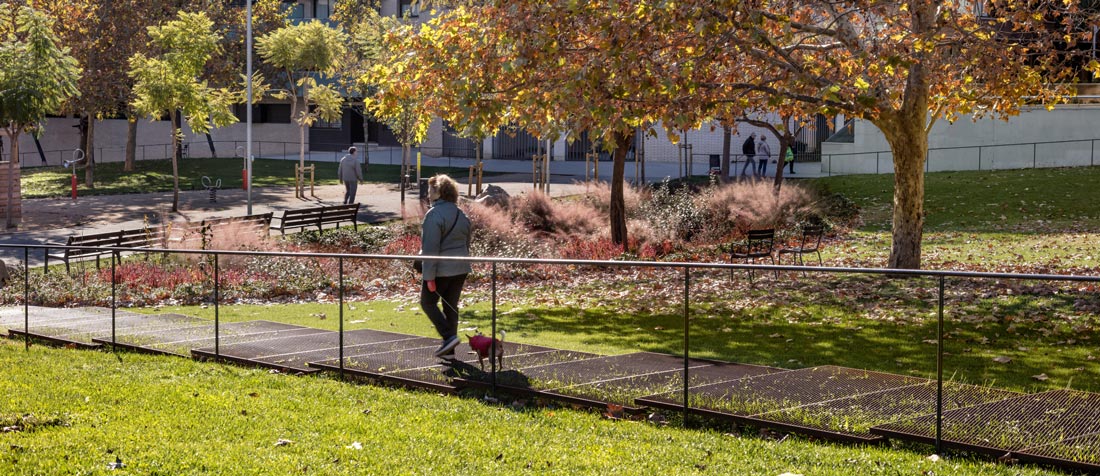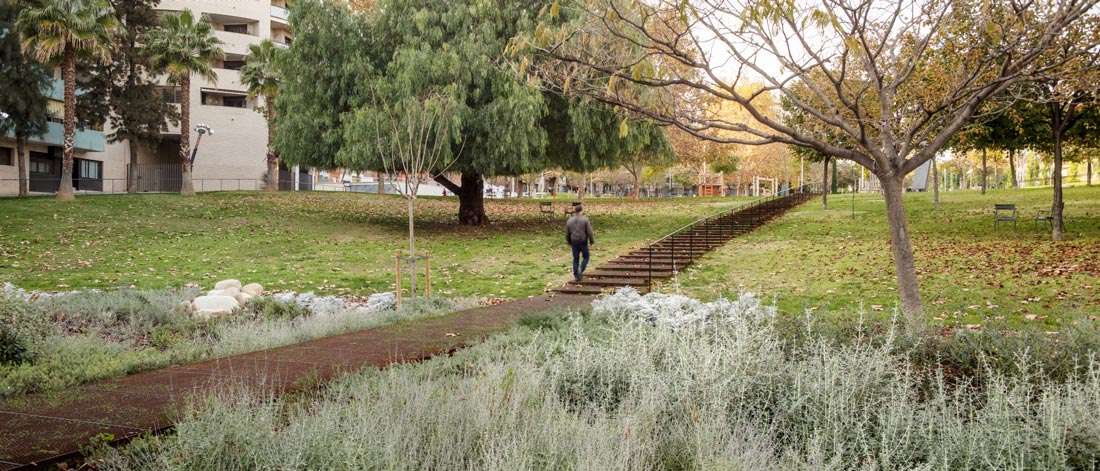Alps Avenue used to be a road with no trees, heavy traffic from cars and lorries, four lanes for vehicles, and cars parked on both sides of the street at various angles. This setup created a bleak and lifeless environment with little urban development. The main objective was to reduce vehicle traffic and transform the avenue into a green corridor connecting the historic centre of Cornellà to Can Mercader Park.
To achieve this connection, the existing Rosa Sensat Park needed to be transformed and adapted into an urban passageway while also improving the quality of the pre-existing green spaces. Three flat granite sand platforms and three sloping grass areas divided the park, bridging the height difference between the platforms. A low fence enclosed the grass areas, preventing pedestrians from walking across them. The park was full of small and large-scale vegetation, and there were insufficient children’s playgrounds. An interesting installation of photovoltaic towers associated with the lighting project needed to be reused.
To achieve ecological restoration, the project was designed with four strategies in mind:
· Naturalize the street
Alps Avenue was transformed from a four-lane road with mainly industrial uses into a new green corridor linking the urban centre of Cornellà de Llobregat with the historic Can Mercader Park. The pavements were widened, a cycle lane was added, and the vegetation on the road was improved.
· Connect the park
Pedestrian permeability through Rosa Sensat Park was improved by creating three new corridors, connecting the urban fabric on both sides of the park and facilitating the city’s continuity without changing the existing topography.
· Restore the ecology of the park
The vegetation’s water self-sufficiency was improved with areas for rainwater retention and infiltration. The grass area was extended, and new shrubs and trees were introduced to enhance the new layouts in the park.
· Upgrade the park
All the existing urban items were reused, the photovoltaic structures were maintained, and the number of children’s play items and seating was increased to improve the habitability and people’s use of the park.
The project identified and improved existing features of interest in the area, connecting them to create a green urban corridor.
The avenue was transformed into a green corridor with only two lanes (one in each direction), new trees, and a line of shrubs along the entire length of the road, alongside a cycle lane.
The topography of the park remained unchanged, and the fences surrounding the grass areas were removed to make the park more permeable. Three major concrete paths 5 m wide crossed the park, creating a link between the old town centre and Alps Avenue. There were three considerably flatter areas, which were divided in two by the major paths. The semicircular part at the foot of the grassy slope collected the surface rainwater run-off and became a water retention area with plenty of shrub vegetation and draining soil. These new seating areas were used for the existing relocated benches. The other part of the platforms were children’s play areas – one with green grass, and the other with granite sand.
One year after the completion of the works, Alps Avenue had been replanted and had become a new green corridor that many people used. The urban connections worked perfectly, and many people crossed the park on their way to other parts of town. It was now a lively green space that had been rediscovered by the public. Many children used the play areas, and many older people strolled and relaxed in the park, enjoying its good position and the new vegetation.






























